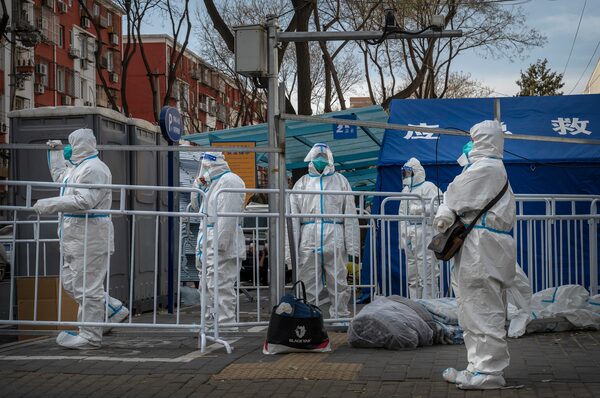
Epidemic control workers stand guard outside a community in lockdown, in Beijing, on Nov. 29.Kevin Frayer/Getty Images
Beijing has acknowledged the public anger surrounding its tough COVID-19 policies, just days after anti-lockdown protests in cities across the country.
However, at a news conference in the capital Tuesday, top health officials did not chart a course out of the government’s zero-COVID strategy but instead laid the blame on overzealous local authorities who applied measures “excessively and arbitrarily.”
“Imprecise, untargeted containment policies jeopardize people’s lives and livelihoods,” said Cheng Youquan, the deputy director of the Supervision Bureau of the National Health Commission (NHC). “This is not aligned with national policies.”
He said “lockdowns should be quick, and the removal of them should be equally quick,” adding that Beijing will name and shame localities that fail to follow its guidance.
Over the weekend, thousands of people in Shanghai, Beijing and at least 10 other cities took to the streets. What began as a show of mourning for the victims of a recent apartment fire in Xinjiang – the deadliness of which has been blamed on lockdown measures – soon turned into angry demonstrations denouncing pandemic measures and the government generally, with some protesters chanting for President Xi Jinping to step down.
By Chinese standards, Tuesday’s news conference was relatively conciliatory, with officials recognizing that people are unhappy with the current situation. Only once – in the sole question from a non-state media journalist – were the protests directly referenced. NHC spokesman Mi Feng did not acknowledge the unrest but said China’s COVID-19 policies were “being fine-tuned and evolving constantly.”
His colleague Chang Zhaouri, a researcher at the Chinese Center for Disease Control and Prevention, said that’s partly because the Omicron variant, which is swiftly becoming the predominant strain in China, as it is elsewhere, is “substantially weaker” than Delta, an earlier variant.
“International researchers have shown a substantial decrease in mortality and the number of severe cases caused by Omicron,” she said.
In a rare show of weakness, China’s censors struggled to keep up with zero-COVID protests
But while Tuesday’s event offered some hope of a gradual easing of COVID-19 measures – as Beijing has been signalling for weeks now, even before the protests – it also made clear that this would not be happening quickly, given the country’s current spike in the number of cases.
China reported 38,421 new cases Tuesday, a drop from Sunday’s record high of 40,347 but still sharply higher than the start of the month, when daily caseloads hovered around 10,000.
“The pandemic is rapidly evolving,” Mr. Cheng said Tuesday, warning that some areas of the country were facing “the grimmest and most challenging situation since the outbreak of the pandemic.”
The biggest challenge facing Chinese authorities in easing current measures is vaccination coverage. While the population is generally well protected, with more than 90 per cent having received at least three doses, older groups – those most at risk of severe illness and death from COVID-19 – have relatively poor vaccination rates.
According to the NHC’s latest statistics, about 86 per cent of people 60 and older have been vaccinated three times; among people 80 and older, just 65.8 per cent. Most have only received two jabs, even though three doses are generally recommended to protect against Omicron. Many countries around the world are currently administering fourth doses.
Given the size of China’s population, that means millions are at risk. A major wave of infections could overwhelm the country’s health care system, particularly in rural areas.
“Elderly people who are eligible to get vaccinated are advised to do so as soon as possible,” said Guo Yanhong, an inspector of the NHC’s Medical Administration Bureau. Officials announced a renewed push for vaccination, including the use of new inhaled doses, but did not outline any other measures to persuade recalcitrant parts of the population, such as the mandatory vaccine passes used in Hong Kong.
For the first two years of the pandemic, most Chinese were supportive, even proud, of the country’s COVID-19 measures. But this year has seen people grow increasingly resentful, particularly in urban areas, where residents have been subjected to frequent testing and snap lockdowns with no indication of when such measures might end, even as the rest of Asia opened up.
A series of deadly incidents linked to COVID-19 measures – including a quarantine bus crash and the Xinjiang fire – has seen public frustration turn to anger.
The weekend protests have ebbed since Monday, with heavy police presence in both Beijing and Shanghai. Some people who showed up at protest areas were seen being taken away, and many of those who participated over the weekend are being arrested. Protesters have been frantically deleting photos and chat messages that could tie them to the demonstrations, even as some received summonses to local police stations.
Wu Qiang, an independent political scholar based in Beijing, said the movement that began this month will be “difficult to sustain under the repression” that is already kicking in. But it was nevertheless a major political crisis for the Communist Party.
“China’s ruling classes have always made the prevention of colour revolutions a major focus,” he said. But just weeks after Mr. Xi secured a third term as party leader in a display of his absolute power, and amid intense repression of civil society and dissidents, the spontaneous, decentralized protests still managed to erupt across the country.
“This massive, cross-class movement is unprecedented,” he added.
 James Griffiths
James Griffiths